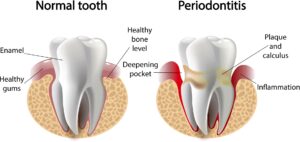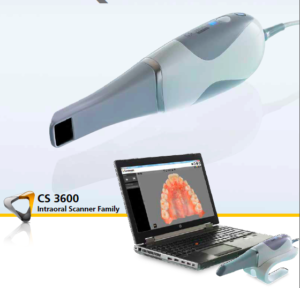Header logo
header top contact widget
Dental Technology
Nothing To Fear To Accomplish Healthy Smile Here
Posted on Apr 16, 2023 by William J. Claiborne, DDS MS
As a dental specialist, I find that many people are unfamiliar with exactly what a periodontist does. Yet, when they are recommended to see me (typically by their general dentist), it is because they need specialized care that falls under our unique set of skills.
A periodontist has advanced skills to help patients with a variety of needs that involve the gum tissues. These include:
– Treatment of all stages of gum disease (gingivitis, pregnancy gingivitis, periodontal disease, periodontitis)
– Reshaping gum tissues for esthetic enhancement (crown lengthening, gingivectomy for ‘gummy smiles’, repairing areas of gum recession)
– Diagnosis and placement of dental implants
– Treatment of lesions or cysts in oral tissues
Let’s begin with gum disease.
Because the majority of care I provide has to do with the treatment of all stages of periodontal disease, it may be helpful to understand how this develops. Although many people delay or avoid regular dental care (mistakenly thinking “if nothing hurts, then nothing must be wrong”), I have a close-up view of its destructive nature. Its formation creates cavities, periodontal (gum) disease, and leads to eventual tooth loss.
Even people who are committed to a regimen of thorough at-home oral hygiene (twice-daily brushing, daily flossing), can be doing an insufficient job of removing the daily buildup of plaque. Plaque is a sticky film of bacteria that accumulates in the mouth. When not thoroughly removed, it can harden into a mass that attaches to the base of, or in-between, teeth.
In the form of tartar, this cement-hard mass of bacteria cannot be brushed or flossed away. Once tartar forms, it can only be removed by a dentist or hygienist using special tools. Without removal, it will continue to amass and attack gum tissues, working its way beneath the gum line.
Below the gums lie the support system for natural teeth, consisting of tissues, ligaments and bone. When the bacteria reach an uncontrollable level, they become infectious. As these infectious bacteria accumulate further, symptoms of gum disease become more apparent, such as tender or swollen gums or seeing blood in the sink when brushing teeth. Breath odor may be bad on a regular basis.
As symptoms worsen, the gums become red with infectious and loosen their grip around the base of teeth. The gums may become spongy and pus pockets may form. Breath odor at this point is persistently putrid. Eventually, the structures that support teeth are compromised and teeth may loosen. Gum disease is the leading cause of adult tooth loss in the U.S.
Research has found that certain strains of oral bacteria from gum disease create reactions in the body that can trigger systemic inflammation. Thus far, research findings have shown a correlation between periodontal disease bacteria and some cancers (including pancreatic and lung), Alzheimer’s disease, pre-term babies, heart disease, stroke, diabetes, arthritis and erectile dysfunction (ED).
As if all that weren’t bad enough, one study suggests that gum disease relates to a reduction in one’s quality of life: “Periodontal disease has been linked to lower quality of life.” “Quality of life encompasses several domains, including psychological functioning and social relationships among others. Oral health-related quality of life has been shown to be reduced in patients with periodontal disease.” (https://www.hindawi.com/journals/prm/2017/5491923/)
While estimates show about 75 percent of American adults have some degree of dental fear or anxiety, over 47 percent have some level of periodontal disease. As a periodontist, both are alarming numbers. Nearly half our nation is walking around with a potentially life-threatening disease in their mouths.
Treating this may sound like it would be pretty intimidating. However, Although there are many treatments offered and at various levels, our main goal is to provide patients with comfortable and positive experiences at every visit. One way we accomplish this is through the advanced technology featured here in our Western North Carolina periodontal dental office. We feature some of the most advanced in dentistry, much of which is not available in dental offices elsewhere. Some of these features include:
LANAP With PerioLase MVP 7: Laser-Assisted New Attachment Procedure is an advanced protocol that efficiently and effectively treats advanced gum disease with the added advantages of a dental laser. This offers a non-surgical alternative for patients with moderate to severe periodontal disease. LANAP treatment leaves very little discomfort and has a quick recovery time. It has also been found to stimulate bone regrowth in damaged areas.
3D Cone Beam Imaging: Ideal for diagnoses and treatment planning, these images provide a clear view of the upper and lower jaw, used for: intricate review of endodontics; periodontics; orthodontics; implantology: TMJ; and prosthodontics, as well as dental and maxillofacial surgery. Because cone beam radiographs show sagittal, axial, and coronal planes, locating and tracking nerve canals optimizes implant placement. The process is quick, painless and at minimal levels of radiation.
CareStream Cone Beam Computer Tomography Imaging: This enhanced tomography works with 3D imaging for exceptional detail and range.
CS 3600 Intraoral Scanner: Rather than make impressions with bulky, goopy trays, this scanner quickly and comfortably captures digital impressions accurately and easily for creating precision models or appliances (crowns, inlays, onlays, bridges, orthodontic appliances and aligners, custom abutments). The scanner can also reach difficult–to–access areas in the patient’s mouth for superior results with improved patient comfort.
Computerized Dental Implant Placement: This advanced system for pre-surgical positioning of dental implants uses a 3D model of the patient’s jaw. Once the implant type is selected, a template is developed for optimal treatment success, even for complex cases.
In addition, we offer a unique environment for comfort. We understand how dental fear or anxiety can cause people to delay or avoid having dental treatment, sometimes for decades. We believe that every patient deserves respect, a gentle touch and knowing they are in a “lecture free” zone. For those who have high fear levels, we offer several sedation options, including oral and IV sedation.
Oral sedation is a pill that helps patients relax. It also has an amnesiac effect, leaving most with little or no memory of treatment afterward.
I.V. sedation (also known as ‘twilight sleep’) places the patient in a deeper sleep state and erases memory of the procedure. It is administered by a doctor of anesthesiology for optimal comfort and safety. In our Asheville office, anesthesia is overseen by a Medical Doctor (MD) who is a board certified Anesthesiologist.
With both sedation options, patients are closely monitored with advanced safety equipment throughout treatment.
I hope I’ve given you a helpful and positive picture of what a periodontist does and how he/she can help you with some challenging needs; all the while keeping you comfortable, minimizing treatment time, and shortening treatment time.
Although most of our patients are referred to us by other dentists and dental specialists, a referral is not required for accepting a new patient. Call 828-274-9440 if you feel we can make recommendations for your specific needs or provide helpful information.
Helping To Curtail Opioid Misuse
Posted on Mar 23, 2023 by William J. Claiborne, DDS MS
No one wants to be in pain. In the dental office, dentists and dental specialists see many patients enduring a great deal of pain, some of which increases in time to excruciating levels.
To resolve the pain, treating the affected area is the first step. Healing can take time and may involve a period of continued discomfort. While a dental profession wants to help patients avoid problems and pain that can arise from them, helping you get through painful periods with ease is certainly a priority.
Like others in the health care field, the field of dentistry has become rather resistant to prescribing harsh and addictive painkillers. The opioid epidemic in the U.S. is running rampant and we want to do our part in curtailing the availability of these meds.
I felt it may be helpful to share some statistics and research findings on the opioid use in America. Hopefully, this information will reassure that the dental profession is not being “stingy” with prescribing painkillers. We are trying to help control what can easily be misused or over-prescribed.
Drug overdose deaths involving prescription opioids rose from 3,442 in 1999 to 17,029 in 2017. From 2017 to 2019, the number of deaths declined to 14,139. This was followed by a slight increase in 2020, with 16,416 reported deaths. In 2021, the number of reported deaths involving prescription opioids totaled 16,706. These numbers are headed in the wrong direction, obviously.
Although physicians, dentists and others in health care have been under close scrutiny for the number of opioids prescribed, dentists are also being more diligent in limiting patient access to pain medications. Yet, there is still a concerning number who make access easier than it should be.
According to International Association for Dental Research findings shared from two studies amongst dentists and oral-maxillofacial surgeons (OMFS) (presented in March 2023), the goal is to identify high prescribers of opioids. The study, conducted at the University of Pittsburgh, used data to detect actively prescribing dentists between 2015-2019.
The study found that during this period, 2,741,030 opioids were prescribed by 199,145 dentists/OMFS. Researchers noted that over 35% of prescribers prescribed at low rates in 2015 with this percentage falling to nearly 18% in 2019. In this period, those who were “moderate” prescribers of opioids also decreased prescribing by over 82%. A slightly more active group of prescribers also decreased their number of these prescriptions.
However, 3.5% of prescribers found to be consistent in opioid prescriptions decreased in number, yet with minimal decline. For these, the rate in 2015 averaged nearly 55%. In 2019, the average was only down to 44.7%.
A particular concern in prescribing opioids is that of prescriptions submitted for children. While total opioid prescriptions have decreased in patients under 25 years of age, trends in opioid prescribing for children, adolescents, and younger adults (under 25 years of age) remains a concern.
In a study from 2013 – 2018, researchers found the opioid dispensing rate for younger patients decreased annually at a rate of approximately 15%. The largest decreases were noted for patients ages 15 to 24 years. Among children aged 0 to 5 years for whom an opioid was dispensed, the investigators observed annual increases from 2011 to 2014. For high-dosage prescriptions, these decreased from 2014 to 2018 although high-dosage, extended-release or long-acting remained at a concerning rate — nearly 28%.
Even amid an epidemic of abuse, opioid painkillers are still commonly prescribed to teenagers and young adults for conditions like tooth and back pain. Between 2005 and 2015, opioids were prescribed to teens and college-age adults at nearly 57 million visits to doctors’ offices and emergency departments.
Although more common in an ER, 15% of visits concluded with an opioid prescription with only a small decline over the 10-year study period.
A report on opioid prescription misuse by the University of Michigan shared another concern that contributes to the problem. When people get a prescription for opioid painkillers to ease pain, it is assumed that the patient has it filled right away. However, there are now findings that show some of these prescriptions are being filled more than a month later, long after acute pain should have subsided.
In 2019, 1% of opioid prescriptions from dentists and surgeons were filled more than 30 days after writing. Although the number is low, that percentage equates to more than 260,000 opioid prescriptions a year in the U.S.
This indicates to prescribing surgeons and dentists that the medications are being used for other than intended. Whether over-prescribed by the doctor or misuse by the patient, this adds to the risk factor for opioid overdose.
These delayed-fill findings have led to call for state and federal laws to better regulate the expiration periods for filling these prescriptions. Changing the systems of monitoring along these lines has been slow in coming. In 2019, 18 states allowed prescriptions for opioids and other controlled substances to be filled up to 6 months after writing with 8 states allowing dispension up to 1 year after the prescription date.
The entire team at our Asheville periodontal dental office is highly committed to providing patients with optimal comfort throughout treatment. Here, we make oral sedation available as well as I.V. sedation (“twilight sleep”). These help patients to relax fully or snooze during treatment, erasing most (or all) memory of treatment afterward.
We also want our patients to heal comfortably after periodontal treatment or dental implant placement. As a periodontist, this is helped by being respectful of gum tissues and all areas in the mouth DURING procedures. We work with each patient to help them remain comfortable during their post-procedure time. Often, this can occur without the need for heavy medications with many patients only requiring OCT pain meds.
When it comes to your treatment, our advanced imaging technology helps us to pinpoint precise areas for incisions, which helps to minimize discomfort and speed healing time. Additionally, performing treatment at an easy pace allows for minimal disruption to sensitive gum tissues.
A periodontist has advanced skills in the treatment of all stages of gum disease, the re-contouring of gum tissues, and in the placement of dental implants. This dental specialist can help provide an optimal result while helping you enjoy the highest level of comfort – during and after treatment.
Please call 828-274-9440 if you have questions about comfort, treatment, or dental fear. New patients are always welcome and a referral is not always needed.
“Gray Tsunami” Brings New Numbers in Dementia, Alzheimer’s
Posted on Feb 11, 2023 by William J. Claiborne, DDS MS
The American Academy of Periodontology (perio.org), defines a periodontist as:
“A periodontist is a dentist who specializes in the prevention, diagnosis, and treatment of periodontal disease, and in the placement of dental implants. Periodontists are also experts in the treatment of oral inflammation. Periodontists receive extensive training in these areas, including three additional years of education beyond dental school. They are familiar with the latest techniques for diagnosing and treating periodontal disease, and are also trained in performing cosmetic periodontal procedures.”
As an Asheville periodontal specialist for over 25 years, my advanced skills help patients with a variety of needs that involve the gum tissues. These include:- Treatment of all stages of gum disease (gingivitis, pregnancy gingivitis, periodontal disease, periodontitis)
– Reshaping gum tissues for esthetic enhancement (crown lengthening, gingivectomy for ‘gummy smiles’, repairing areas of gum recession)
– Diagnosis and placement of dental implants
– Treatment of lesions or cysts in oral tissues
Why should you be concerned about the health of your gums?
Gum disease is an inflammatory disease that attacks gum tissues, teeth, and the structures that support them. It is the nation’s leading cause of adult tooth loss. As if that weren’t bad enough, research has shown that these potent bacteria are able to activate the development (or worsen the progress) of other diseases.
Past studies have shown oral bacteria from gum disease can be a contributing factor to heart disease, stroke, some cancers, diabetes, preterm babies, erectile dysfunction (ED), high blood pressure, and impotency. Studies have begun to closely study the links between gum disease and Alzheimer’s disease.
In the U.S., the growing prevalence of dementia and Alzheimer’s disease is an especially concerning issue as our aging population grows. If you are a “baby boomer” (born between the years 1946 – 1964), you make up a significant percentage of adults. Within 7 years, boomers” will comprise 21% of the population. By 2060, nearly 1 in 4 Americans will be 65 years and older, dubbed the “gray tsunami.” Seniors over the age of 85 will have tripled, with half a million adults having reached age 100-plus.
While the statistics of aging adults increase, these stats for ALL adults over the age of 30 should set off some alarms. Nearly half of the adult population has some level of gum disease, over 47%.
There is a misconception many have when it comes to the serious nature of gum disease. Too often, people perceive “if it doesn’t hurt, then nothing is wrong” when it comes to their oral health. Although symptoms of gum disease may include tender gums that bleed when brushing, gum disease can begin without any obvious signs.
This is true for many health problems. For instance, when cancer forms in the body, its initial presence isn’t obvious. This is why annual or periodic screenings are urged since treatment is typically minimal during early stages.
Early treatment, including that for gum disease, helps to resolve the problem without complex measures. This is why it is so important to have 6-month dental check-ups. These visits allow your dentist to catch gum disease early so treatment needs and expense can be minimal.
Yet gum disease is a hazard for your overall health as well. While gum disease forms in the mouth, that’s not necessarily where it remains without proper treatment. The bacteria of gum disease can enter the bloodstream. It has been found to trigger serious reactions elsewhere in the body. Some of these lead to the formation of cancer (oral, throat, pancreatic, lung) and some activate conditions such as diabetes and arthritis.
Obviously, the health of your mouth is an important part of supporting a healthy body, especially in disease prevention. To illustrate the extent of gum disease’s damaging impact to health, research is tracking its correlation to dementia and Alzheimer’s disease.
In a recent study that included over 8,200 adults, an increased risk for developing dementia was found in those having severe gum disease and missing teeth. Participants in the study had an average age of 63 at the study’s onset.
In a follow-up after 18 years, those who had severe gingivitis in addition to tooth loss had a 22% higher risk for developing Alzheimer’s disease or dementia. Having no natural teeth was associated with a 26% increased risk.
Broken down, 14% of individuals with healthy gums and all their teeth at the start of the study developed dementia by the end of the study. For those with mild gum disease, 18% (623 out of 3,470) developed dementia. Twenty-two percent of participants with severe gum disease developed dementia. For those who had no remaining teeth, 23% developed dementia – nearly 17 cases for every 1,000 persons.
They found the bacteria present in periodontal disease can travel through the mucous membranes of the mouth to the brain, potentially causing brain damage.
In the study, participants were carefully assessed based on age, gender, education, cholesterol, high blood pressure, coronary heart disease, smoking and body weight. (https://psychcentral.com/news/2020/07/30/gum-disease-may-be-linked-to-later-dementia/158497.html?MvBriefArticleId=25473)
Prior studies have led researchers to be more focused on tracking oral tissue related factors that may contribute to dementia and Alzheimer’s disease, which is affecting a growing percentage of American adults (as well as those globally). Currently, 10% of adults age 65 and over have Alzheimer’s disease. For people ages 85 and older, this increases to 32 percent. In the U.S., it is the 6th leading cause of death. (https://www.alzheimers.net/resources/alzheimers-statistics/)
By the year 2025, the number of people 65 and older with Alzheimer’s disease is expected to reach 7.1 million people, a 27 percent increase from the 5.6 million age 65 and older in 2019.
Let us help you minimize the risks associated with oral bacteria. If dental fear has kept you from having regular dental care, we will be happy to discuss our many comfort options in our comfortable Asheville office, including Oral and I.V. sedation (“twilight sleep”).
Oral sedation is a pill that helps patients relax. It also has an amnesiac effect, leaving most with little or no memory of treatment afterward. I.V. sedation (also known as ‘twilight sleep’) places the patient in a deeper sleep state and erases memory of the procedure. It is administered by a doctor of anesthesiology for optimal comfort and safety.
Here, our Western North Carolina periodontal dental office also features some of the most advanced technology in dentistry. Many of these are not available in other dental offices elsewhere. Some of these features include LANAP (Laser-Assisted New Attachment Procedure. This is an advanced protocol that efficiently and effectively treats advanced gum disease with the added advantages of a dental laser. We also have 3-D Cone Beam Imaging, computerized Tomography imaging and one of the latest in intraoral scanners.
Now, more than ever, we know that maintaining a healthy smile is important and achievable for every adult. If you suspect you have gum disease (gums that bleed when brushing, tender or swollen gums, gums that have reddened or receded from teeth), it is important to be seen by a periodontist. A periodontal specialist is the best way to restore any level of gum disease to help you regain a healthy smile.
Be committed to having excellent oral health as and make it a priority as an important part of your overall health. For a consultation to discuss how a periodontist can help you, call 828-274-9440.
Men: Gums Can Impact Erectile Dysfunction (ED) and Heart Health
Posted on Jan 24, 2023 by William J. Claiborne, DDS MS
It may be an awkward subject, but the issue of erectile dysfunction (ED) seems to appear rather frequently via TV commercials. I see ads for pills and medical clinics rather often. Agreeably, it is a problem estimated to affect a rather large percentage of men. For those ages 40 – 70, it affects over 40%. Nearly 70% of men at age 70 are affected.
https://www.clevelandclinicmeded.com/medicalpubs/diseasemanagement/endocrinology/erectile-dysfunction/
In no way am I wanting to dissuade a male from medications or seeking treatment. However, as an Asheville NC periodontal specialist, I want to relay an issue that may be a bigger influence in ED than many are aware.
Below are findings of several studies showing that periodontitis (advanced gum disease) to be a significant risk factor for erectile dysfunction. Rather telling is as gum disease worsens, so does erection impairment.
• In a study of 162 males ages 30 to 40, Turkish researchers found that 82 of the participants had normal erection function while 80 who complained of ED, nearly half. Some men in both groups had chronic periodontitis, but the condition was more than twice as prevalent in the ED group. Men with periodontitis accompanied by decayed or missing teeth had the greatest level of ED.
• In another study conducted at the University of Granada School of Dentistry, 80 male participants who had severe gum disease were more than twice as likely to suffer from erectile dysfunction. This was true even after adjustments were made for other issues that could distort the findings. In the study, 74% of the participants with ED also presented with chronic periodontitis.
• Israeli researchers conducted a survey of the erection function of 305 men with an average age 40. The participants were given a thorough examination of their gums. Those with chronic periodontitis had the greatest risk of ED.
• Research has shown that men with indicators of periodontal disease such as red, swollen or tender gums as well as prostatitis (inflammation of the prostate) have higher levels of PSA than men with only one of the conditions. This means that prostate health may be associated with periodontal health, and vice versa.
Men with gum disease showed a higher risk of developing impotence due to inflammation associated with periodontal disease. This inflammation has been known to damage to blood vessels, which can lead to impotency. Men younger than 30 or older than 70 are especially at risk.
A separate study found that men with a history of gum disease are 14% more likely at risk for cancer than men with healthy gums. Specifically, men with periodontal disease are 49% more likely than women to develop kidney cancer, 54% more likely to develop pancreatic cancer, and 30% more likely to develop blood cancers.
For over two decades, medical researchers have closely focused on inflammation in the body and its power to activate health problems, heart and cardiovascular diseases in particular. However, men have notably higher risks in some areas in addition to ED, one being the heart.
When it comes to ED and heart disease, the connection to periodontal disease has emerged as an independent risk factor. Cardiovascular disease raises risk for ED. Thus, anything that increases the risk for cardiovascular disease (such as smoking, obesity, chronic stress, high cholesterol, high blood pressure, and chronic sleep apnea) also raises the risk of ED.
Men, especially, need to know that they should be committed to having healthy teeth and gums. Research has found that periodontal disease is higher in men (56.4%) than in women (38.4%) – an 18% difference. https://www.perio.org/consumer/gum-disease-and-men
According to a survey by the Centers For Disease Control & Prevention (CDC), only 66% of males brush their teeth twice or more a day compared with 86% of females who do so.
This was revealed through a study of over 800 participants. Evaluation included a written questionnaire on dental knowledge and oral health habits. It also included an oral exam of each participant to detect signs of periodontal disease. (https://www.perio.org/consumer/gender-differences)
Flossing had even worse numbers, but that pertains to both sexes. Only 49% in the survey claim to floss daily. Only 1 out of 3 assumed that seeing blood in the sink when brushing is normal and unaware of it as a sign of periodontal (gum) disease.
Regardless of gender, over time an inadequate daily oral hygiene leads to an overload of bacteria in the mouth. For people who have habits such as smoking, unhealthy diets, and alcohol consumption, their vulnerability is even greater.
This is also true for people as they age. Aging contributes to a reduced ability to produce saliva, the mouth’s oral rinsing agent. When saliva flow fails to rinse away bacteria at sufficient levels, the accumulation runs rampant.
As a Western NC periodontist, I have an up-close view of the damaging affects of insufficient oral hygiene. It often results in tooth loss, which is (contrary to many perceptions) NOT a natural part of the aging process. Having natural teeth for a lifetime is more than achievable and has even been shown to add to one’s lifespan (by up to ten years).
If you haven’t been fully committed to your oral health, there is no better time to begin than the present. Start the year with a thorough periodontal examination. Call 828-274-9440.
If dental fears have caused you to delay or avoid having regular dental care, consider beginning with a consultation. This occurs in a comfortable, private consultation room that is removed from the clinical side of the office. Too, many treatments can include oral or I.V. sedation (sleep dentistry, or “twilight sleep”).
And, if financial constraints are an obstacle in receiving treatment, we offer several payment plans. Most are interest-free with no down payment required (for qualified individuals). Feel free to ask about these during your consultation.
Recent Posts
Categories
Archives
- September 2024
- August 2024
- July 2024
- June 2024
- May 2024
- April 2024
- March 2024
- February 2024
- January 2024
- December 2023
- November 2023
- October 2023
- September 2023
- August 2023
- July 2023
- June 2023
- May 2023
- April 2023
- March 2023
- February 2023
- January 2023
- December 2022
- November 2022
- October 2022
- September 2022
- August 2022
- July 2022
- June 2022
- May 2022
- April 2022
- March 2022
- February 2022
- January 2022
- December 2021
- November 2021
- October 2021
- September 2021
- August 2021
- July 2021
- June 2021
- May 2021
- April 2021
- March 2021
- February 2021
- January 2021
- December 2020
- November 2020
- October 2020
- September 2020
- August 2020
- July 2020
- June 2020
- May 2020
- April 2020
- March 2020
- February 2020
- January 2020
- December 2019
- November 2019
- October 2019
- September 2019
- August 2019
- July 2019
- June 2019
- May 2019
- April 2019
- March 2019
- February 2019
- January 2019
- December 2018
- November 2018
- October 2018
- September 2018
- August 2018
- July 2018
- June 2018
- May 2018
- April 2018
- March 2018
- February 2018
- January 2018
- December 2017
- November 2017
- October 2017
- September 2017
- August 2017
- July 2017
- June 2017
- May 2017
- April 2017
- March 2017
- February 2017
- January 2017
- December 2016
- November 2016
- October 2016
- September 2016
- August 2016
- July 2016
- June 2016
- May 2016
- April 2016
- March 2016
- February 2016
- January 2016
- December 2015
- November 2015
- October 2015
- September 2015
- August 2015
- July 2015
- June 2015
- May 2015
- April 2015
- March 2015
- February 2015
- January 2015
- December 2014
- November 2014
- October 2014
- September 2014
- August 2014
- July 2014
- June 2014
- May 2014
- April 2014
- March 2014
- February 2014
- January 2014
- December 2013
- November 2013
- October 2013
- September 2013
- August 2013
- July 2013
- June 2013
- May 2013
- April 2013
- March 2013
- February 2013
- January 2013
- December 2012
- November 2012
- October 2012
- September 2012
- August 2012
- July 2012
- June 2012


